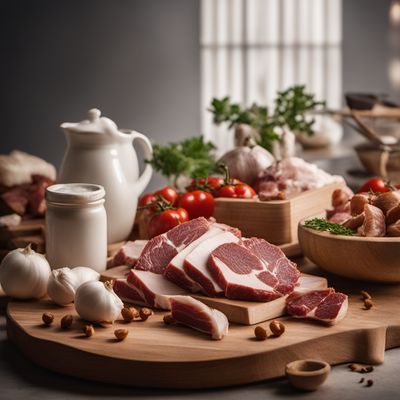
Ingredient
Mammals other slaughtering products
Exploring the Culinary World of Mammal By-Products
Mammals other slaughtering products include a variety of ingredients such as offal (organ meats), bones, fat, and specialty cuts that are not commonly consumed in mainstream Western diets. These ingredients offer distinct flavors and textures that can elevate dishes when prepared with care and creativity. From the rich and creamy taste of beef liver to the tender and flavorful oxtail, each mammal by-product brings its own unique characteristics to the table.
Origins and history
The use of mammal by-products in cooking can be traced back to ancient times when humans utilized every part of the animal for sustenance. Different cultures around the world have developed their own culinary traditions and recipes using these ingredients. For example, in French cuisine, foie gras (duck or goose liver) is considered a delicacy, while in Chinese cuisine, braised pork trotters are a popular dish. Today, these ingredients continue to be valued for their versatility and ability to add depth of flavor to a wide range of dishes.
Nutritional information
Mammal by-products are a good source of essential nutrients, including vitamins, minerals, and proteins. Organ meats, in particular, are rich in iron, vitamin B12, and other micronutrients. However, it is important to note that these ingredients can also be high in cholesterol and saturated fats. As with any ingredient, moderation and balance are key to incorporating mammal by-products into a healthy diet.
Allergens
Mammal by-products, particularly organ meats, may pose a risk for individuals with certain health conditions or dietary restrictions. Those with gout, kidney problems, or iron overload disorders should exercise caution when consuming organ meats due to their high purine and iron content. It is advisable to consult with a healthcare professional or registered dietitian for personalized guidance.
How to select
When selecting mammal by-products, it is important to choose high-quality ingredients from reputable sources. Look for fresh, well-trimmed cuts that have a vibrant color and minimal odor. If purchasing organ meats, ensure they are from healthy animals and have been properly cleaned and handled. It is also recommended to purchase from local farmers or trusted suppliers who prioritize animal welfare and sustainable practices.
Storage recommendations
To maintain the freshness and quality of mammal by-products, it is important to store them properly. Fresh cuts should be refrigerated at temperatures below 40°F (4°C) and consumed within a few days. Organ meats, in particular, should be used within a shorter timeframe to prevent spoilage. Freezing is also an option for extending the shelf life of these ingredients. It is advisable to wrap them tightly in freezer-safe packaging and label them with the date of freezing for easy reference.
How to produce
Producing mammal by-products requires specialized knowledge and facilities, making it challenging for amateur enthusiasts to produce these ingredients at home. It is best to rely on professional butchers or meat processors who have the expertise and equipment to handle these products safely and efficiently.
Preparation tips
When preparing mammal by-products, it is essential to follow proper food safety practices and cooking techniques. Organ meats should be cooked thoroughly to ensure they reach a safe internal temperature. Specialty cuts like oxtail or beef cheeks benefit from slow cooking methods such as braising or stewing to achieve tenderness. Fat from mammals can be rendered and used for frying or as a flavoring agent in various dishes. Experimenting with different recipes and flavor combinations can help unlock the full potential of these ingredients.
Culinary uses
Mammal by-products are used in a wide range of culinary applications around the world. Organ meats are commonly used in traditional dishes such as pâtés, terrines, and sausages, adding depth and complexity to the flavors. Specialty cuts like oxtail or beef cheeks are often braised or stewed to create hearty and flavorful dishes. Fat from mammals, such as lard or tallow, is used for frying, baking, or as a flavor enhancer in various cuisines. These ingredients are particularly valued in nose-to-tail cooking, where every part of the animal is utilized.
More ingredients from this category

Deer, other slaughtering products
The Wild Delicacy: Deer and Slaughtering Products

Sheep other slaughtering products
Versatile Ingredients: Sheep Offal

Equine other slaughtering products (generic)
Unveiling the Culinary Secrets of Horse Meat

Goat other slaughtering products
Beyond Meat: Goat Edition

Pig other slaughtering products
Exploring the Versatility of Pork By-Products

Rabbit, other slaughtering products
The Versatile Delicacy: Rabbit and Slaughtering Products

Wild boar, other slaughtering products
Untamed Delicacies: Exploring the World of Wild Boar and Slaughtering Products

Bovine other slaughtering products
Beyond the Steak: Exploring Bovine Offal